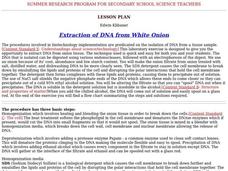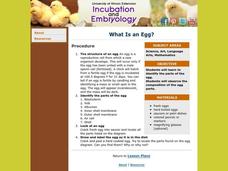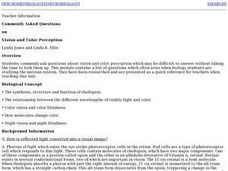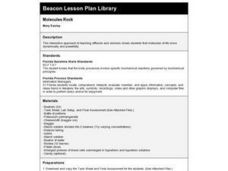Curated OER
Extraction of DNA from White Onion
Students investigate techniques involved in extracting and isolating DNA. Students extract and observe onion DNA.
Curated OER
Characteristics of Living Things
Seventh graders identify the characteristics of living and non-living things. In this biology lesson, 7th graders define vocabulary words as they go through the lesson. They answer a crossword puzzle after class discussion.
Curated OER
Discovering the Structure of the Atom
Students investigate atomic and nuclear structure of matter by researching historical atomic theories. Students examine Rutherford's studies and discover that many scientific conclusions change over time as new data is collected.
Curated OER
DRY UP BABY ! ANHYDROBIOSIS (freeze drying)
In this lab, young scholars explore how organisms are able to survive the extreme environmental conditions found in the Polar regions. Students observe and draw active living rotifers and Tardigrades, design and perform experiments to...
Curated OER
Diversity/ Organisms Word Search Puzzle
In this literacy worksheet, students practice looking for the words that are related to the idea that is focused upon in the sheet. The skill of spelling is used and vocabulary increases.
Curated OER
Neurons, Hormones and the Brain
In this psychology worksheet, students complete 5 short answer questions about how the neurons and hormones work together together with the brain.
Curated OER
Synaptic Transmission Worksheet
In this synaptic transmission worksheet, students determine how information is transmitted from one neuron to the next plus describe the function of neurotransmitters and neuromodulators. This worksheet has 12 fill in the blank and 4...
Curated OER
Observing Osmosis in a Chicken Egg
Tenth graders develop a hypothesis and explain what they observed on an activity. In this investigative instructional activity students observe osmosis and report their data using a graph.
Curated OER
Egg Parts
In this parts of an egg activity, students label a detailed diagram with 8 parts of an egg. There is a word bank of words but no information given here.
Curated OER
The Nervous System from A to Z
In this nervous system alphabet book activity, learners study 26 neuroscience terms as they read the 26 terms and their definitions in the glossary. Some of the terms included are: receptor, unipolar, white matter, axon, hemisphere, and...
Curated OER
What Is an Egg?
Students identify the parts of the egg and observe the composition of the egg parts.
Curated OER
DNA: What Does It Mean?
Tenth graders explore DNA using online tutorial. They perform their own DNA extraction from a clove of garlic and identify the key components of DNA.
Curated OER
Diversity of Life
Students identify the difference between eukaryote and prokaryotes and examine the structure of bacteria. In this bacteria lesson students examine the different ways that bacteria are classified through an activity.
Curated OER
Viruses and Bacteria
Reviewing the key terms and ideas from a chapter about viruses and bacteria, this activity helps students to reinforce their knowledge about the makeup and life cycle of a virus. Students answer true/false questions, blanks from a word...
Curated OER
The Endocrine Systems
In this endocrine system worksheet, students review the structures and functions of the parts that make up the endocrine system. This worksheet has 7 fill in the blank and 6 matching questions.
Curated OER
Viruses
In this biology lesson, students complete a crossword puzzle with 35 questions about viruses. They identify the different types of viruses and the diseases they bring.
Curated OER
Eggs: A Practical Application
Students examine the chemical and physical nature of eggs and their role in food preparation.
Curated OER
Sequencing the Cystic Fibrosis Gene: A Simulation
Ninth graders determine nucleotide sequences. They identify those base sequences that are normal, those that are normal variants and those that cause cystic fibrosis. Students use DNA nucleotide sequences to determine amino acid...
Curated OER
Describe the Perfect Pathogen
Young scholars develop a pathogen based upon their knowledge of pathogens and after presenting it to the class, they then suggest ways that the pathogen might be combated. Next they identify possible physical or behavioral changes in a...
Curated OER
Cellular Transport
In this cellular transport worksheet, high schoolers review the process of osmosis and compare passive transport and active transport. This worksheet has 12 matching questions.
Curated OER
Commonly Asked Questions on Vision and Color Perception
Students commonly ask question about vision and color perception which may be difficult to answer without taking. They use this module that contains a list of questions which often arise when biology students are studying the nervous...
Curated OER
What Is an Egg Without its Shell?
Young scholars observe osmosis, a cellular process that normally can't be observed without a microscope, and use scientific method to observe osmosis in a chicken egg.
Curated OER
Fungi Crossword
In this biology worksheet, students complete a crossword puzzle with 28 questions about fungi. They identify the different parts of a fungus.
Curated OER
Molecules Rock
Fourth graders engage in this interactive lesson which illustrates diffusion and osmosis and shows them that molecules of life move dynamically and powerfully. They must analyze their lab orally and in writing.
Other popular searches
- Analogies for Cell Membrane
- Cell Membrane Egg Vinegar
- Cell Membrane Transport
- Cell Membrane Structure
- Cell Membrane Pictures
- Cell Membrane Model
- Bubbles Cell Membrane
- Cell Membrane Permeability
- Permeable Cell Membranes
- Cell Membrane and Diffusion
- Cell Membrane Lesson Plan
- Cell Membranes and Transport























